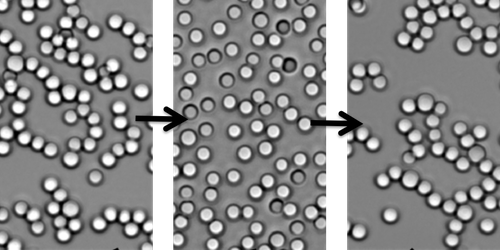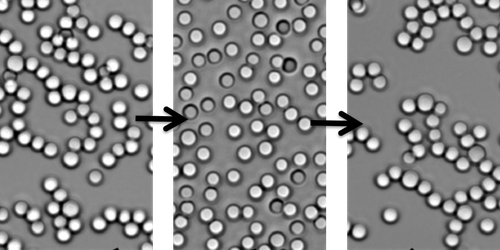Reversible Self-Assembly of Macroscopic “Polymers”
Programming materials to reconfigure themselves into new structures might sound like science fiction, but researchers are working on exactly that goal. Now a team led by Jasna Brujic from New York University has taken a step toward realizing such a material from micrometer-sized drops linked together with DNA. They demonstrate large-scale self-assembly of the drops into long polymer-like chains that they then repeatedly destroy and rebuild by changing the temperature. While the team has, so far, only created 2D chains from these so-called colloidomers, they say that the system could potentially lead to 3D materials that can be continuously reconfigured.
The basis for the team’s material is a solution containing drops formed by mixing oil and water. The researchers added two types of DNA to the solution—a complimentary pair that could bind together. When one strand of each type attached to two nearby drops, they could form a "bond." By varying the DNA concentration in the solution, the team tuned the number of “bonds” between the drops, creating linear chains from drops with two bonds and branched networks from drops with three or more bonds. By heating the solution, the team melted the DNA, causing the chains to disassemble. The structures then spontaneously reassembled after a subsequent cooling.
Using this method, the team bulk synthesized over 22,000 colloidomers with lengths ranging from 2 to 20 drops. (Researchers have created similar structures from solid particles linked with DNA, but the synthesis was on a much smaller scale and proceeded via a different route.) Analyzing the statistical behavior of the chains, the team found that they are fully flexible—the chains can arrange themselves into any configuration—much like their tinier polymer cousins. The team says that they are working on creating 3D colloidomers, a step that requires matching the densities and refractive indices of the various liquids.
This research is published in Physical Review Letters.
–Katherine Wright
Katherine Wright is a Senior Editor of Physics.





